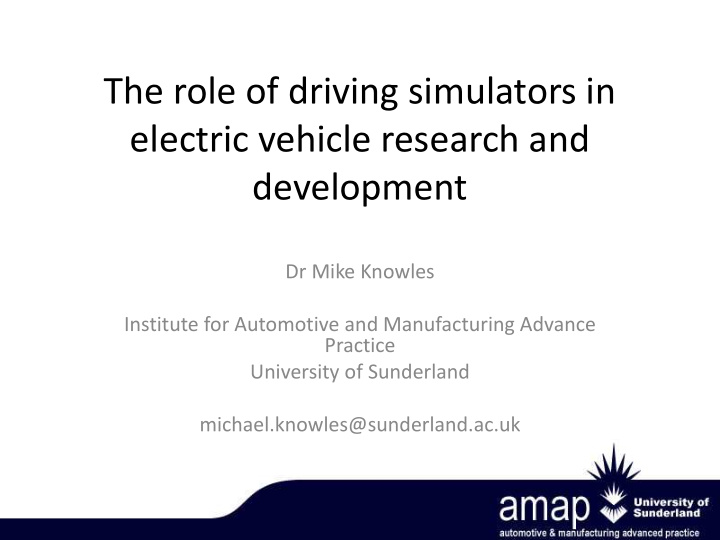



The role of driving simulators in electric vehicle research and development Dr Mike Knowles Institute for Automotive and Manufacturing Advance Practice University of Sunderland michael.knowles@sunderland.ac.uk
Contents • About AMAP • History of Simulation lab • EV research at AMAP • How Driving Simulation can contribute to low carbon motoring • Future aspirations
Who we are • AMAP is part of the Faculty of Applied Sciences within the University of Sunderland • AMAP is active in a number of projects in: – Ultra Low Carbon Vehicles – Digital Manufacturing – Reliability and Condition Monitoring – Industrial Maintenance and Efficiency
Simulator lab • The AMAP Driving Simulator Lab was established in 1999. • Projects have focussed on a variety of areas ranging from Human Factors to Vehicle Design • We currently have two driving simulators: – Developed In-House – Forum 8
Developed In-House Simulator • Three projection screens for maximum immersion • Cockpit hardware developed by AMAP
Applications • Previous work on the simulator includes: – AGILE (Aged people Integration, mobility, safety and quality of Life Enhancement through driving) – Age-related visual search during right turn gap acceptance maneuvers – Ability to perform a simulated emergency stop wearing a leg cast or brace – Cognition in pregnancy: perception and performance
Applications • Used alongside equipment such as eye-tracker, EEG • Used to assess driver behaviour in a variety of scenarios
Forum8 Simulator • Acquired in 2010 • The display consists of three 32 inch LCD screens
• New configuration:
Ultra Low Carbon Vehicle Research • Begun in 2006 • Focus areas – Human factors • Efficient driving techniques – Drive trains and gearboxes – Electrical energy conversion • Power flow control PhD
Examples of EV projects
Driving Simulation and ULCV Research • 3 Critical Issues for EV development – Driveability – optimisation research should be based upon realistic driving conditions rather than standard patterns. – Braking behaviour – regenerative braking means energy can be recovered but such systems should not compromise safety. – Practical design – research currently done leaves many implementation issues; e.g. some methods for control are just too computationally intensive.
Driving Simulator Applications: Dynamometer Interconnection • A test platform for EV drive train components was developed in 2011 • Motors, batteries, controllers etc can be tested under realistic conditions
Driving Simulator Applications: Dynamometer Interconnection • We are now working towards inteconnection between the driving simulator and the dynamometer Control positions and Motor power with geographical information full data logging Motor control (gradient etc) Motor Motor Forum8 Dynamic Controller Driving Model Simulator Mechanical loading based on Dynamometer gradient and vehicle properties Dynamometer Controller Vehicle speed Motor speed under specified load
Driving Simulator Applications: Dynamometer Interconnection • The vehicle’s physical properties can be modified to suit the application
Driving Simulator Applications: Vehicle models • The Forum8 UCWinRoad software provides a detailed Internal Combustion Engine Model • Using the Software Development Kit we plan to develop models of hybrid and fully electric vehicles • This will allow us to evaluate the driveability and efficiency of these vehicles with real drivers
Driving Simulator Applications: Vehicle Models • Integration of simulator with MATLAB/Simulink models for human in the loop evaluation
Eco driver training: DROPLET • The Forum 8 driving simulator was recently used in the delivery and evaluation of a new Eco driving course for safe driving. • The course, named the DROPLET Course (Driver Optimisation for Low Emissions Transport) is based on theoretical models of driver training and provides a comprehensive framework for goals and content of driver education. • A driving simulator, classroom-based and on-road driving techniques were used to modify driver behaviour.
Eco driver training: DROPLET • Eco-drive Plugin provides information on fuel economy of journey • A substantially larger improvement was evident in participants who took the on-road training course
Supporting developments: creation of bespoke routes • In order to evaluate vehicles and hardware we have a local test route which comprises three distinct driving styles. • We are currently working towards creating this route in the simulator
Supporting Developments: Creation of Bespoke Routes • In order to create bespoke routes several enabling technologies have been developed
Future development plans • Ongoing development of dynamometer interconnection – Addition of second motor to hardware test platform • Development of more local routes • Development of driver training courses for more efficient driving • Use of custom routes to evaluate vehicles in the situations where they will operate • Use of vehicle models to evaluate the effects of driver behaviour on vehicle reliability
Thanks for your attention.... ANY QUESTIONS?
Recommend
More recommend